Bunkerfilter introduces new bunker products
Related Articles
Bunkerfilter is the low cost filtration system which prevents sand and silt blocking up bunker drains which causes flooding. The products have already been in successful use at golf courses for several years with no need for intervention. They are easily installed by ground staff and can save thousands of pounds in replacing blocked drains.

One of the challenges of draining bunkers is that the sump is often close to and sometimes even below the water table during very wet periods. Problem bunkers usually have this challenge and in discussions with greenkeepers the company saw the need for a new special version for use in these situations.
The new Type 4 Bunkerfilter is even shorter than the standard product (250mm instead of 350mm) which requires a shorter hole at the bunker sump. It is also manufactured using readily available plastic drainage components which easily retrofit with standard drains.
The Type 4 Bunkerfilter still retains the class leading flow rate of 30 litres per minute (about 6 gallons per minute) which is more than adequate to allow drainage of most bunkers. As with the standard product, very large bunkers may require 2 Bunkerfilters.
Trentham Golf Club has recently installed a Type 4 Bunkerfilter in a greenside bunker on hole 15.
Previously, the hole 15 bunker at Trentham used a French drain which, although only installed for about 10 years, no longer cleared the bunker of water after heavy rain. When removed this drain was completely blocked with compacted sand and silt the sump drain end in the bunker.
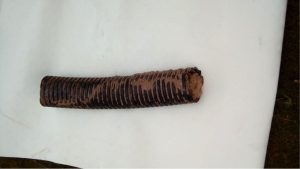
Section of blocked drain removed from bunker
Trentham chose the Type 4 for a low lying hole because of the performance of standard Bunkerfilters at several other holes over the years.
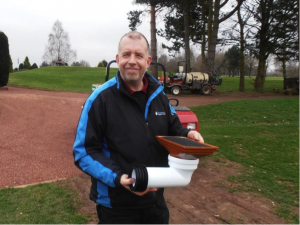
Edward Stant, course manager at Trentham with the Mk4 Bunkerfilter
In some situations it is physically impossible to flow away water in bunkers using pipes. This may be where the bunker is low lying or where drainage is prevented by an impervious layer of clay. For these situations it has also developed the new Type 5 Bunkerfilter which fits over a sump made using an auger. The sump may either be made deep enough to allow the impervious layer to be penetrated or larger enough to accommodate the water during peak flow periods (this will only work if the sump is above the water table).
Type 5 Bunkerfilter is installed by clearing the bunker of old sand followed by drilling two or three cylindrical sumps (one for each 10m2 area of bunker surface) each 1 – 1.5 meters deep using a 25cm diameter augur. If possible, it is essential that any clay layer is fully penetrated to make sure that the new sumps empty by percolation. The sumps are filled with round pebbles or adsorbent 20-25 mm media and then a 10.5 inch Bunkerfilter conical piece is fitted at the top to filter the rainwater to prevent any sand from blocking the sump over time. The top of the filter is set down below the sand base by 50mm and then covered by new sand before filling the bunker with new sand .
Type 5 filters can be purchased from Bunkerfilter Ltd along with the appropriate amount of adsorbent media.
Note: It is recommended that all fairway run off is stopped by, if necessary, small adjustments to the profile of the turf, to prevent silt containing water from entering the bunker. Every 10 m2 of sand in a bunker has to remove, in storm conditions, a loading of rainwater fallen directly onto the bunker of about 250 kgs in addition to any fairway runoff which always contains silt which ruins bunkers and drains.
The Bunkerfilter proprietary sand retention filtration media, proven to work in the field for years, has been installed into lower profile mouldings giving the newly released Type 4 product:
- Significantly reduced working height (by about 30%) for use in bunkers that are low lying with poor drainage.
- The required hole depth in the bunker base is reduced from 350 mm height to 250 mm height.
- Quicker to install
- Standard easier to connect pipe fittings have also been used.
- This shows how important proper bunker drainage protection is.
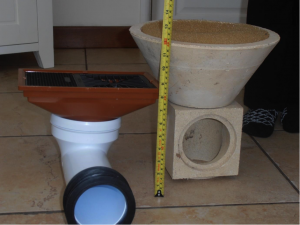
Installation instructions are the same for exisiting Bunkerfilter products except that the hole at the base of the bunker will be 100 mm shallower.
Most golf courses have a few bunkers that take over six hours or more to clear after rain and are almost impossible to drain using conventional drainage systems. Some have a persistent wet area most of the time. In these situations sumps are usually the only route but they quickly block up.
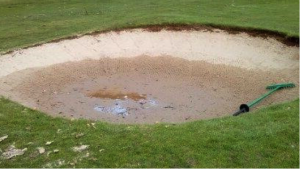
Bunkerfilter has developed a solution using its proprietary sand retention filtration media unit, proven to work in the field for years, which is installed on top of a newly dug sump:
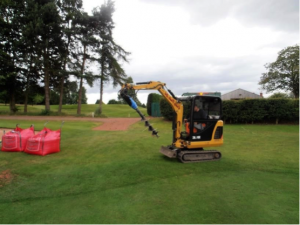
- Allows drainage of those impossible to drain bunkers.
- Significantly increases sump life.
- Simple and quick to install using your grounds team. Quick to install.
- The area affected is cleared of sand and the lowest point is marked.
- Using a 10 inch diameter augur, a hole of bored to a depth of at least 1 to 1.5 meters (the deeper the better).
- The bore holea is filled with aggregate (typically 25 mm) to within 200 mm of the base of the bunker.
- A Type 4 Bunkerfilter media unit is then fitted so that its top remains 50 mm below the base of the bunker.
- New sand is then placed on top of the Bunkerfilter unit.
- The bunker is then re-filled, preferably with new sand because sand in such bunkers is usually full of clay and soil.

























